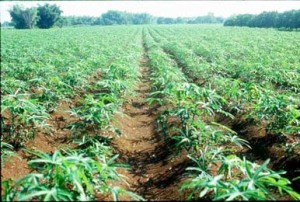Cassava farmers in Nigeria and Zambia who have adopted mechanised production and improved farming practices reap up to four times additional yield and attract higher purchase prices through structured market linkages, according to the African Agricultural Technology Foundation (AATF)

Farmers participating in the African Agricultural Technology Foundation’s (AATF) Cassava Mechanisation and Agro-processing Project (CAMAP) in Nigeria and Zambia realised a boost in their 2014 harvests as they harvested up to four times the usual tonnage they previously received from cassava crop produced manually. According to George Marechera, the Business Development Manager at AATF, farmers in Osun state, Nigeria received between 28 and 33 tonnes of cassava per hectare compared to the 7 tonnes per hectare they previously harvested. In Zambia, farmers realised an average of 24 tonnes per hectare up from the usual average of five tonnes from the crop harvested this year that was planted in 2013.
“The harvested tubers also attracted higher purchase prices through structured market linkages between farmers and processors facilitated by the project. Processors collected the cassava tubers from farmers’ fields, reducing the duration of time to market which is key to preserving the quality of the tubers and ensuring it is processed within 12 hours of harvest,” said Marechera.
CAMAP uses a value chain approach to address constraints that smallholder farmers face in the cultivation of cassava. The project encourages use of improved high yielding and disease resistant cassava varieties; use of planters which ensures stems are well cut and properly planted; application of fertiliser and herbicides; weeding and use of root diggers for harvesting. The project also supports market linkages which helps farmers get good returns for their crop.
Cassava though an exceptionally important crop in the two countries, faces numerous production and processing challenges. These include limited or no access to cassava mechanised farming equipment and processing technologies. “CAMAP has the potential to intervene across the entire value chain of cassava production in Zambia and Nigeria and indeed in Sub-Saharan Africa (SSA)” added Marechera.
The goal of (CAMAP) is to enhance the contribution of cassava production and processing technologies for sustainable improvement in food security, incomes and livelihoods of farmers, processors, and marketers in the cassava sector. This is being achieved through upgrading and expanding traditional planting, harvesting and processing techniques that will contribute to development of competitive cassava commodity value chains for a reliable supply of processed products for food and non-food industrial use.
CAMAP is a public-private partnership that is being coordinated by the African Agricultural Technology Foundation (AATF) and in Nigeria involves the National Centre for Agricultural
Mechanisation (NCAM), National Root Crops Research Institute (NRCRI) and the governments of Kwara, Ogun, Kogi and Osun states. In Zambia, AATF is partnering with the Ministry of Agriculture and Cooperatives and the Zambia Agricultural Research Institute and in Uganda with the National Crops Resources Research Institute.
According to Dr Denis T. Kyetere, the Executive Director of AATF, agricultural mechanisation is one of AATF’s key priority areas of work that will ensure that crops like cassava contribute their rightful share in the alleviation of food insecurity in SSA.
Nigeria and Zambia were the first pilot countries for the project whose operations kicked off in 2012. Uganda joined the project in 2013 and activity implementation including mechanised planting started in July 2014.
Cassava is an important food crop both for urban and rural consumers in SSA and is a basic staple food in Nigeria, Mozambique, Zambia, Democratic Republic of Congo, Ghana, Malawi, Uganda and Tanzania making Africa the largest cassava producing region in the world. The competitiveness of African cassava manufactured products at the world market has been low because it is produced and processed for subsistence, not as a commercial crop.
CAMAP is aimed at affecting change along the cassava value chain: planting, harvesting, processing, value addition and market linkages. The project is enhancing smallholder capacity in planting, harvesting, and processing and enterprise development to improve food security, create wealth, generate employment and boost the rural economy.
In Nigeria the project is being piloted in four states – Kwara, Kogi, Ogun and Osun. In Zambia the project is in Kaoma district in Western province, and Mansa and Samfya districts in Luapula province. To date, over 2,500 hectares have been planted in the three countries states. The process involved land preparation using tractor drawn ploughs and harrows, sourcing of improved cassava varieties for planting materials, planting using cassava planters, and application of pre-emergence pesticides using boom sprayers. More land will be put under the crop during the 2015 planting season.
The mechanisation equipment being accessed by CAMAP is for cultivation, planting, weeding, harvesting, peeling, dewatering, drying, chipping, roasting, milling and processing cassava into various cassava products. The project is targeting 3.5 million farmers in SSA.
